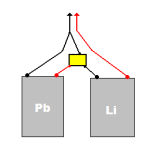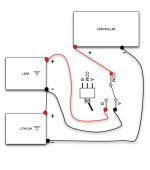CGameProgrammer
10 kW
Are there any complications or dangers involved when mixing battery types in series? Like lead-acid and lithium? Assume each pack is already wired for individual use. The only things I'm aware of is that the total current for the system will be determined by the lowest-current pack, and that each pack should probably be charged one at a time... correct?
EDIT: I thought of another complication. Obviously lead-acid won't last as long as lithium, so it would be nice if the bike would simply stop using the lead-acid batteries when they get too depleted and just use the lithium. But this won't happen automatically, right? Instead, it would keep attempting to draw power from the lead-acid batteries if the lithiums are still giving enough voltage, possibly permanently damaging the lead-acid batteries... right? So I guess a user-operated switch should be used to toggle the lead-acid on or off? Like in the attached picture. What's a good switch to use for this? I've never used one before.
EDIT: I thought of another complication. Obviously lead-acid won't last as long as lithium, so it would be nice if the bike would simply stop using the lead-acid batteries when they get too depleted and just use the lithium. But this won't happen automatically, right? Instead, it would keep attempting to draw power from the lead-acid batteries if the lithiums are still giving enough voltage, possibly permanently damaging the lead-acid batteries... right? So I guess a user-operated switch should be used to toggle the lead-acid on or off? Like in the attached picture. What's a good switch to use for this? I've never used one before.



